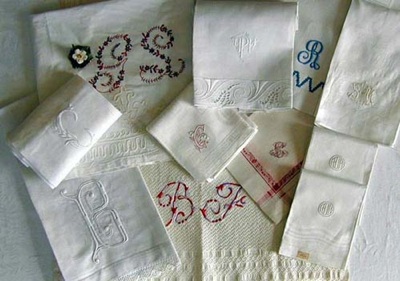
Vintage linens heating up
By Associated Press
Features Party and event Trends and technology September 26, 2011 - Contemporary home decor is yielding a little this season to a more traditional style evocative of the Edwardian and Victorian eras, according to AP writer, Kim Cook. Current trends include steamer trunks used as tables, Victorian illustrative prints and wallpapers, and new versions of period furniture. Photo courtesy of Cynthia's Linen Room
September 26, 2011 - Contemporary home decor is yielding a little this season to a more traditional style evocative of the Edwardian and Victorian eras, according to AP writer, Kim Cook. Current trends include steamer trunks used as tables, Victorian illustrative prints and wallpapers, and new versions of period furniture. Photo courtesy of Cynthia's Linen Room
September 26, 2011 – Contemporary home decor is yielding a little this
season to a more traditional style evocative of the Edwardian and
Victorian eras, according to AP writer, Kim Cook. Current trends include
steamer trunks used as tables, Victorian illustrative prints and
wallpapers, and new versions of period furniture.
If you're interested in experimenting with this look without going all in, consider vintage linens.
The craftsmanship and uniqueness of fine old linens draw collectors, as well as decorators who like to mix old and new: a
vintage quilt on a modern slab bed, for example, or an antique lace tablecloth dressed with chic tableware.
Once considered an important part of a woman's personal belongings, vintage cotton and damask napery, bed and bath linens
are often wonderful examples of the loom and needle arts. Textile weaving, lace tatting and embroidery could take craftspeople
hundreds of hours. The resulting pieces were treasured, loved and passed along through families. And sooner or later, some are given
up to the marketplace, for new owners to enjoy.
English-born Anna Redgrave of Annapolis Royal, N.S., owns Highland Lace, a vintage linens web shop. Her lifelong passion for
antique textiles was nurtured by her grandmother, a member of the Royal Needlework Society and a seamstress at Buckingham Palace.
"She was responsible for finding and sewing all the embellishments on the ball gowns,'' says Redgrave. The Society was
the same group that, 60 years later, made the overlay of lace on Kate Middleton's dress.
Redgrave sells lace curtains, embroidered linen napkins, cutwork cotton cloths and a variety of items crafted of repurposed linens,
from the turn of the century through the 1950s.
Jane Nicholson is a designer and decorator, also in Annapolis Royal, who has created elegant yet welcoming spaces in Ottawa and Montreal that meld modern and traditional styles. She began her textile collection with a 90-year-old set of lace-trimmed bed linens passed down from her great aunt. They were made by an order of nuns for her aunt's trousseau in her small village in Belgium.
"But she never married.'' says Nicholson. "Her fiance was killed in World War I, and she never used them. They passed to my
aunt who also never used them. Finally they came to me, and I have them on my two mahogany guest beds.''
Where and what to look for
There's a large vintage-linen fan base, Redgrave says, and French monogrammed pieces, linen napkins and vintage lace hankies
sell out fast. "Monogrammed pieces were usually handed down, so they're highly valued,'' Redgrave says. A woman would have her
personal and household linens embroidered with her initials because they were part of her personal wealth, and went with her when she
married. Nicholson looks for linens with a nice weave. "If you're buying '40s and '50s tablecloths, look for good workmanship and
strong colour.''
Look for linens that have a soft hand and a warm' smell, Redgrave advises. "Damasks should shimmer, and shouldn't smell
musty or bleached,'' she says.
Flea markets, tag sales, estate auctions, thrift shops and vintage stores are all good sources, but try to glean the provenance
of your find. To whom did the piece belong? Was it woven in this country? Was it part of a trousseau? "Information like that makes
the piece come alive,'' says Nicholson.
Caring for old linens
Redgrave soaks yellowed or spotted pieces in warm, slightly soapy water overnight, then mixes up 60 ml Oxiclean, a stain
remover, with 6.5 litres of water. After a few hours of steeping the garment in that mixture, she rinses it with warm water, pats it with
towels and lays it flat in bright sunshine.
Nicholson is also a fan of sunshine to naturally bleach and dry linens, but she uses Sunlight bar soap to gently rub soiled areas,
then pours hot water through the stain before laying the garment out to dry.
Storing vintage linens
Redgrave recommends an old practice of rolling linens around a tube, often covered with a cotton print, to deter moths from nesting
in creases. Nicholson rolls hers in soft white cotton sheets. Place lavender sachets in the tubes or between the layers.
You can also store pieces in acid-free tissue, available at craft stores. Never store linens in plastic, which encourages mould.
How to use them
If you find a linen item you love but it's not in the best of shape, don't pass it by. Torn seams and holes can be darned, a stain
can be hidden with a clever fold, a large piece can be cut and the salvaged remnant made into a pillow or mounted under glass.
Use vintage lace-edged sheets as curtains, bedspreads, even room dividers.
Put embroidered hand towels in powder rooms. They serve well as wine glass towels, too. Have a tailor make them into little pillows
or baby quilts as gifts, if you don't sew yourself.
Learn more
The Book of Fine Linen, Francoise de Bonneville's in-depth look at the history and range of household linens, was recently
re-published in English by Flammarion (2011). Full of lively stories, information and images, it's an excellent resource for
anyone interested in collecting or learning about the subject.
Related links
Highland Lace
Mrs. Nicholson
Print this page
Leave a Reply